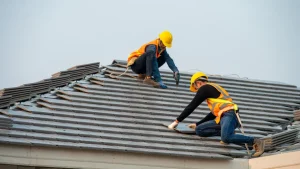Introduction: Knowing When It’s Time for a Roof Replacement
Your home’s roof is a crucial protective barrier, shielding it from the elements. Over time, however, wear and tear take their toll, necessitating a roof replacement. This guide will provide you with essential insights to make an informed decision about replacing your roof.

Factors Influencing Roof Replacement Costs
Several factors contribute to the cost of a roof replacement:
- Roof Size: The square footage of your roof plays a significant role in determining the overall cost.
- Roof Pitch: Steeper roofs require more safety precautions and labor, which can increase costs.
- Material Choice: Different roofing materials have varying costs. Asphalt shingles are typically more affordable than metal or slate.
- Labor Costs: Labor expenses include the cost of removing the old roof, installing the new one, and any necessary repairs.
- Roofing Accessories: Elements like underlayment, flashing, and ventilation contribute to the cost.
- Location: Local labor rates and material availability can impact the overall price.
Step-by-Step Guide to Roof Replacement
- Assessment and Planning: Determine if a replacement is necessary. Look for signs of damage such as missing shingles, leaks, or sagging. Plan the project timeline and budget.
- Obtaining Permits: Depending on local regulations, you might need permits for a roof replacement. Check with your local authorities.
- Choosing Materials: Select the roofing material that best suits your budget, climate, and aesthetic preferences.
- Removing the Old Roof: The old roofing material is removed carefully, and the underlying structure is inspected for any damage.
- Repairing Substrate: If any damage to the roof deck is discovered, it’s repaired to ensure a solid foundation for the new roof.
- Installing Underlayment and Flashing: A waterproof underlayment is applied, and flashing is installed to prevent leaks around roof openings.
- Installing New Roofing Material: Each roofing material has its installation process. Shingles are laid, metal panels are secured, or tiles are placed, depending on your choice.
- Ventilation and Insulation: Proper ventilation and insulation are essential for energy efficiency and preventing moisture buildup.
- Final Inspections: The completed roof is inspected for quality and compliance with local building codes.
Exploring Different Roofing Materials for Your Replacement
- Asphalt Shingles: Affordable and versatile, asphalt shingles come in various styles and colors.
- Metal Roofing: Known for durability and longevity, metal roofs can withstand harsh weather conditions.
- Wood Shakes: Wooden shingles provide a classic and natural look but require more maintenance.
- Slate Roofing: Expensive but elegant, slate roofs can last for generations with proper care.
- Tile Roofing: Tiles offer a distinct Mediterranean or Spanish aesthetic and are known for their longevity.
Benefits of Professional Roof Replacement
- Expertise: Professional roofers have the knowledge and experience to ensure a proper installation.
- Safety: Roof replacement involves risks, especially with steep roofs. Professionals have the necessary safety equipment and training.
- Warranty: Reputable roofing contractors offer warranties on their work, giving you peace of mind.
- Time Efficiency: Professionals work efficiently, completing the project in a timely manner.
Conclusion
A roof replacement is a significant investment that ensures your home’s protection and enhances its curb appeal. By understanding the factors influencing costs, following a step-by-step process, exploring various roofing materials, and considering professional assistance, you can make a well-informed decision that meets both your needs and your home’s requirements. A sturdy and well-maintained roof not only adds value to your property but also provides you with comfort and security for years to come.












